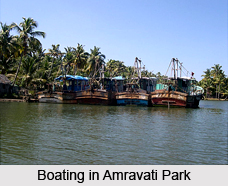 Digha is a seaside resort city situated in the East Midnapur district of the Indian state West Bengal. It serves as one of the most exquisite and popular tourist destinations of the state set along the Bay of Bengal. Beaches of Digha are renowned. Defiant waves colliding against the concrete steps, fishing boats sailing amidst the vast sea and crimson sun peeping out of the horizon are some of the scenes that attract tourists to Digha throughout the year. What distinguishes Digha from other Indian beaches is its unruly sea. There are two beaches in Digha namely the Old Digha beach and the New Digha beach. Whilst the sea at Old Digha is always in a mischievous mood, the waves at New Digha are more suitable for bathing and, thus, is often more crowded.
Digha is a seaside resort city situated in the East Midnapur district of the Indian state West Bengal. It serves as one of the most exquisite and popular tourist destinations of the state set along the Bay of Bengal. Beaches of Digha are renowned. Defiant waves colliding against the concrete steps, fishing boats sailing amidst the vast sea and crimson sun peeping out of the horizon are some of the scenes that attract tourists to Digha throughout the year. What distinguishes Digha from other Indian beaches is its unruly sea. There are two beaches in Digha namely the Old Digha beach and the New Digha beach. Whilst the sea at Old Digha is always in a mischievous mood, the waves at New Digha are more suitable for bathing and, thus, is often more crowded.
History of Digha
The township of Digha was earlier known as Beerkul. Warren Hastings, the Governor General of British India referred to this stunning place as the Brighton of the East. In the year 1923 the place was inhabited by an English businessman John Frank Smith. Digha received much exposure through the writings of this businessman. It was him who convinced Bidhan Chandra Roy, the then Chief Minister of West Bengal, for developing the place into a beach resort.
Geography of Digha
Digha is nestled at an average altitude of 6 metres. It lies at a distance of 183 kilometres from Howrah and 234 kilometres from Kharagpur. Digha mainly enjoys three seasons namely summer, monsoon and winter. Summer continues from April to June during which the temperature reaches to a maximum of 37 degree Celsius. However the cold sea breeze keeps the weather pleasant during this time. From July to September Digha witnesses monsoon season with moderate rainfall and high humidity. In the month of October, winter sets in and lasts till February. During this time the temperature ranges from 24 to 3 degree Celsius.

Tourism in Digha
Old Digha beach has suffered heavy soil erosion owing to the tidal waves however big stones and concrete steps have been constructed to prevent further damage. New Digha, located at a distance of 2 kilometres from Old Digha is comparatively bigger and is well maintained and planned. Unlike Old Digha it is not enclosed by congested localities. Casuarina plants dot the entire beach beautifully. It is a visual treat to witness the advancing and receding waves whilst sauntering along the casuarinas on the sand.
Taking bath in the sea, having a stroll in the serene seaside and cherishing the natural magnificence of the vast sea are some of the common activities in Digha. Curios, stuffs made of shell, hand woven mats and cashew nuts are the popular buys at Digha. The handicrafts here are beautiful and cheap. Various qualities of cashew nuts are available at the shops at both old and new Digha.
Besides the sun kissed sea beach there are several places of interest located around Digha. Within the town, the tourists can explore the Amravati Park in Old Digha. Besotted with various kinds of species of plants, it is also the perfect place for boating. Another interesting place is the Digha Mohona (estuary). The cashew nut farm, located at the Digha-Odisha border, is also a major attraction. Playing volleyball, swimming, horse riding are some of the activities that the enthusiastic travellers can indulge into. A host of places are accessible from Digha. Lying on the border of West Bengal and Odisha, the tourists can explore Talsari, Udaipur Beach and Chandaneswar Temple.
There is also a Marine Aquarium and Research Centre which is worth visiting. Tourists can explore the beaches of Shankarpur, Mandarmoni and Junput.

Visiting Information
Digha is best visited between July and March as the weather remains pleasant during this time. Kolkata is the nearest airport which is about 210 kilometres away from Digha. Though Contai Road (37 kilometres) is the nearest railway station for Digha but Kharagpur and Mechheda on the South-Eastern Railway are the most convenient railheads for Digha from where buses are also available. Local trains from Kolkata halt at Digha station. Buses are available from Kolkata to Digha. One can also hire private cars for travelling. As far as accommodation is concerned there are hotels to suit every pocket. Eating out is fun at Digha.



















